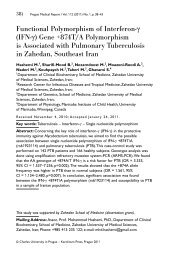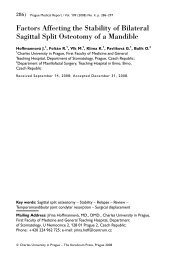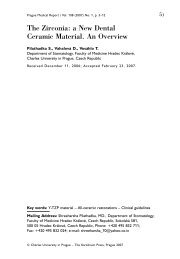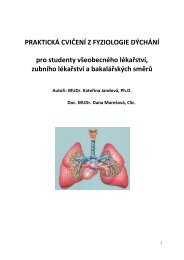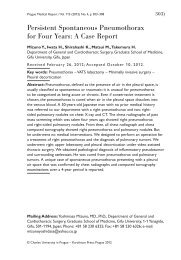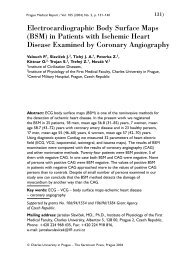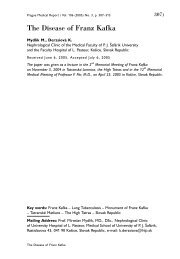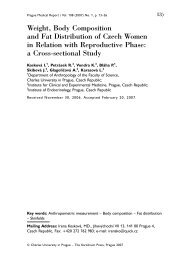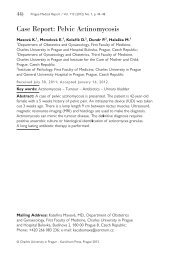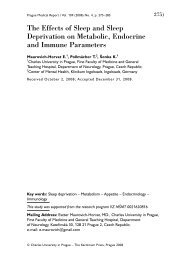ANCA-associated renal vasculitis - ResearchGate
ANCA-associated renal vasculitis - ResearchGate
ANCA-associated renal vasculitis - ResearchGate
You also want an ePaper? Increase the reach of your titles
YUMPU automatically turns print PDFs into web optimized ePapers that Google loves.
242) Prague Medical Report / Vol. 105 (2004) No. 3, p. 237–260often misdiagnosed as an infection or tumor. However, this subdivision issomewhat artificial because approximately 80 percent of such patients eventuallyhave <strong>renal</strong> involvement. The diagnosis of WG is suggested from the clinical andlaboratory findings and from the presence of <strong>ANCA</strong> that are more often directedagainst PR3 (70%) then to MPO (25%). About 5% are <strong>ANCA</strong> negative [26]. Aspreviously mentioned, <strong>renal</strong> disease is common (80%), being manifested by acute<strong>renal</strong> failure and/or active urinary sediment with red cells, red cell and other casts,and proteinuria. Lung involvement have up to 90% of patients with WG, E.N.T.involvement about 90% (Fig. 3), as well. Other organ systems that may becomeinvolved include [27, 28] musculoskeletal system, skin, nervous system, eyes, heartand less commonly gastrointestinal tract, subglottis or trachea, lower genitourinarytract, parotid glands, thyroid, liver, or breast.Microscopic polyangiitis: According to the CHCC nomenclature [2], MPA is anecrotizing <strong>vasculitis</strong>, with few or no immune deposits, affecting small vessels,although necrotizing arteritis involving small and medium-sized arteries may bepresent. Necrotizing glomerulonephritis is very common (90%). Pulmonarycapillaries (Fig. 4) frequently occur (50%), but, by definition, patients with MPA donot have granulomatous respiratory tract lesions. Similarly, E.N.T. lesions mayoccur in MPA (35%), but they are caused by angiitis alone, without granulomatousinflammation. Destruction of bone, for example resulting in septal perforation andFig. 3 – A typical saddle nose deformity ina patient with Wegener’s Granulomatosis.saddle nose deformity, appears to requirenecrotizing granulomatous inflammation (as inWG and CSS) and, therefore, does not occurin MPA. Nodular cutaneous lesions caused bydermal or subcutaneous arteritis and by thenecrotizing granulomatous inflammation ofWG and CSS, are very rare with MPA, otherskin lesions occur often, in up to 40% ofpatients. Neurologic, musculoskeletal andother organ involvement is similar to thosewith WG, eye involvement is less frequentthan in WG. Patients with MPA have MPO-<strong>ANCA</strong> in 50%, PR3-<strong>ANCA</strong> in 40%, and are<strong>ANCA</strong> negative in 10% [28].Churg-Strauss syndrome: According to theCHCC nomenclature [2], CSS is a necrotizing<strong>vasculitis</strong> with eosinophil-rich andgranulomatous inflammation affecting small tomedium-sized vessels, involving therespiratory tract, and is <strong>associated</strong> with asthmaand eosinophilia. In addition to that,neuropathy, migratory or transient pulmonaryŘíhová Z.; Jančová E.; Merta M.; Tesař V.
244) Prague Medical Report / Vol. 105 (2004) No. 3, p. 237–260with crescents with little or no immunoglobulin deposition (pauci-immune) onimmunofluorescence or electron microscopy (Fig. 5). This finding is essentiallydiagnostic of an AAV. However, the histopathological features vary among patientsfrom mild focal segmental extracapillary proliferation to diffuse crescenticnecrotizing glomerulonephritis with granulomas and tubular intra-epithelialinfiltrates. In some cases, extensive glomerulosclerosis is found [30].If performed, the lung biopsy reveals <strong>vasculitis</strong> and granulomatous inflammation inWG. Special stains and cultures have to be performed to exclude the presence ofinfections that can produce granulomas, <strong>vasculitis</strong> or necrosis. Lung biopsy mostoften requires open or thoracoscopic lung biopsy. In a small number of cases(
Prague Medical Report / Vol. 105 (2004) No. 3, p. 237–260245)been observed by other authors [27]. Coxsackie B3 and parvovirus B19 wereimplicated as infectious triggers for <strong>ANCA</strong> and/or WG [34]. An association ofchronic nasal carriage of Staphylococcus aureus with higher relapse rate in WG wasreported [35]. However, microbial pathogens in patients with new onset of WGhave not been identified [36]. Antigenic mimicry is suspected to be an importantfactor in triggering <strong>ANCA</strong> formation. S. aureus genome directly encodes a varietyof serine proteases, which may be cross-reactive with C-<strong>ANCA</strong> [37]. Asmentioned above, a translocation of intracellulary hidden antigens duringnonspecific activation of neutrophils during any inflammation may also be involved.When released from the cell they may become easily accessible to <strong>ANCA</strong>, or mayinduce <strong>ANCA</strong> formation [38].Drugs and chemicals: The existence of drug-induced AAV has been alreadydiscussed. Given the frequency with which the first symptoms of WG occur in therespiratory tract, exposure to noninfectious agents or toxins is another possibleinciting event. The possible candidates are silica dust and organic solvents. Theexposure to silica dust has been repeatedly reported to be significantly higher inpatients with <strong>ANCA</strong> and AAV than in healthy controls, lupus nephritis or otherconditions [39–41].Etiology of AAV – genetic factorsA number of familial cases of WG have been described, and suggested candidategenes include, among others, cytotoxic T-lymphocyte-<strong>associated</strong> protein 4(CTLA-4), interleukin-1 receptor antagonist (IL-1ra), IL-10, and FcgRII/FcgRIII[42]. Mutations in the gene encoding a-1 antitrypsin (AAT), the primary in vivoinhibitor of PR3, are found more frequently in patients with AAV [43]. Thisobservation suggests a potential pathogenic role in this disease for deficient PR3clearance from the sites of inflammation. Decreased local concentrations ofAAT caused by genetic polymorhisms or alterations in the enzyme’sfunctionality induced by inflammation may therefore lead to protease/antiproteaseimbalance in the disease microenvironment. Although unproven, theseevents may be responsible for generating immunogenic forms of PR3 in thesepatients. However, no case of AAV was found among a group of patients havinga heterozygous mutation of this gene [44].Suspected polymorphisms of the TNFa promoter were excluded as riskfactors for the disease in a cohort of German patients [42], but the sameauthors described polymorphism in adhesion molecule CD18 to be <strong>associated</strong>with various forms of AAV [45]. As to HLA class II, alleles DQw7 and DR4haplotypes were found to be <strong>associated</strong> with the persistence of <strong>ANCA</strong> in<strong>vasculitis</strong> [46].In summary, as in other autoimmune diseases, the etiology of AAV isheterogeneous and principally unknown. Different predisposing factors playprobably differential ethiopathogenic roles in various groups of AAV.<strong>ANCA</strong> – Associated Renal Vasculitis
246) Prague Medical Report / Vol. 105 (2004) No. 3, p. 237–260PathogenesisMechanisms of <strong>ANCA</strong> production: The autoantibody response that produces<strong>ANCA</strong> is probably generated against newly exposed epitopes of the targetautoantigen. Following the production of <strong>ANCA</strong>, the antibody response may thengeneralize to the rest of the molecule or to other components of amacromolecular protein complex via the process of epitope spreading. Thishypothesis is supported by a significant role of mononuclear cells in AAV: patientswith active WG have higher levels of CD4+ T cell and monocytic activationmarkers (TNF-alpha, INF-gamma, IL-12) than patients in remission and healthycontrols; IL-10 treatment (which inhibits Th1 pathway by impairing the productionof IL-12) of mononuclear cells from active WG patients impairs the production ofINF-gamma in vitro [47–49].Neutrophil activation and <strong>ANCA</strong>: Once neutrophils are activated (primed) bycytokines, <strong>ANCA</strong> can bind relevant membrane-bound antigens, causing abnormalconstitutive activation via either the crosslinking of MPO or PR3 or the binding ofFc receptors. Persistent <strong>ANCA</strong> binding to neutrophils on the endothelial surfacecan enhance the degree of vascular injury [50]. <strong>ANCA</strong>-antigen complexes adsorbonto endothelial cells where they can participate in in situ immune-complexformation. The degranulation of neutrophils and release of chemoattractants andcytotoxic oxygen free-radicals, also increased by <strong>ANCA</strong>, causes tissue damage[51]. In addition, primed neutrophils not only damage endothelial cells, but alsoattract additional neutrophils to the site of damage, thereby creating an autoamplifyingloop. The release of MPO, PR3, elastase and other proteases fromactivated neutrophils also contributes directly to the local inflammatory process.The role of the endothelial cell: In AAV, endothelial cells may actively recruitinflammatory cells in the early stages of active disease, and enhance their adhesionto sites of vascular injury. They may synthesize PR3 (unproven), which couldparticipate in in situ immune-complex formation [52].Pathogenicity of <strong>ANCA</strong>: A direct evidence for pathogenicity of <strong>ANCA</strong> is arecently described mouse model, that shows that MPO-<strong>ANCA</strong> alone may induce<strong>vasculitis</strong> in mice, deficient in both T and B lymphocytes (Rag2-/-) [53]. Indirectevidence lies in the correlation of <strong>ANCA</strong> (and surface expression of PR3 onneutrophils) with the disease activity [29, 54], in the potential of <strong>ANCA</strong> to bindto target antigens and modify their physiologic function (induction of oxygenradical release, degranulation, inhibition of microbicidal function, defectiveapoptotic process), thereby contributing to tissue damage [51], or in thepotential of <strong>ANCA</strong> to bind to planted antigen on endothelial cell and induction ofendothelial cell injury [55]. The fact that passive transfer of <strong>ANCA</strong> to newbornsthrough the placenta [56] or to experimental animals [57] does not induce<strong>vasculitis</strong> reflects the rather nondirect pathogenic potential of <strong>ANCA</strong>. Moreover,even situations when high titers of <strong>ANCA</strong> do not correlate with active diseaseare not rare [58].Říhová Z.; Jančová E.; Merta M.; Tesař V.
Prague Medical Report / Vol. 105 (2004) No. 3, p. 237–260247)Treatment of <strong>ANCA</strong>-<strong>associated</strong> <strong>vasculitis</strong>Induction therapyPrior to the introduction of immunosuppressive therapy, the outcome of thepatients with AAV was fatal, with most patients dying in less than a year due to avital organ failure [28].Cyclophosphamide: In the early 1980s, Fauci and Wolff introduced a regimencombining daily cyclophosphamide (CYC) therapy given for one year afterremission was achieved with prednisone therapy initiated at a dose of1 mg/kg/b.w./day and tapered on an alternate-day schedule. This treatment(“Fauci-scheme”) has been found to induce remission in 80–100 % of patients andcan result in long-term survival. It was an empirical regimen and therefore entailedconsiderable therapy-related morbidity and mortality. Furthermore, when therapyis tapered and discontinued, relapses are common (in up to 50% of cases).Although CYC treatment is effective in managing the relapses, repeated coursesof CYC are <strong>associated</strong> with bone marrow suppression, infection, cystitis, infertility,myelodysplasia, and transitional-cell carcinoma of the bladder and other secondarymalignancies. As a result, the introduction of immunosuppressants has changed thenatural history of the an acute, progressive and life-threatening disease into achronic, often grumbling one with progressive accumulation of tissue damage dueto disease scars and adverse effects of the therapy [59].For all the above-mentioned reasons, a number of clinical trials aimed atimprovement of induction and maintenance treatment of AAV has been launched.In Europe, the European Vasculitis Study Group (EUVAS) was created graduallyduring the first half of the 1990s and focused on first on diagnostic role of <strong>ANCA</strong>,followed by the standardization of <strong>ANCA</strong> testing, histological assessment andclassification of AAV. It was assumed that despite their different clinicopathologicalcharacteristics, AAV could be studied together, but, for treatment purposes,subclassified based on their severity at presentation as follows:• localized <strong>vasculitis</strong> (with serum creatinine < 120 mmol/L, no constitutionalsymptoms, no threat to any vital organ function and positive or negative <strong>ANCA</strong>)• early systemic <strong>vasculitis</strong> (with serum creatinine < 120 mmol/L and constitutionalsymptoms, no threat to any vital organ function and positive or negative <strong>ANCA</strong>)• generalized <strong>vasculitis</strong> (with serum creatinine < 500 mmol/L and constitutionalsymptoms, dysfunction of any vital organ function and positive <strong>ANCA</strong>)• severe <strong>renal</strong> <strong>vasculitis</strong> (with serum creatinine > 500 mmol/L, constitutionalsymptoms and positive <strong>ANCA</strong>)• refractory <strong>vasculitis</strong> (any serum creatinine, constitutional symptoms, threatenedfunction of any vital organ and positive or negative <strong>ANCA</strong>) [60].The optimal induction treatment of induction of remission in patients withgeneralized, but not immediately life-threatening AAV is currently tested in the<strong>ANCA</strong> – Associated Renal Vasculitis
248) Prague Medical Report / Vol. 105 (2004) No. 3, p. 237–260CYCLOPS trial, where the standard daily oral CYC (2 mg/kg b.w./day for months0–3 and 1.5 mg/kg b.w./day for months 3–6) is compared with pulsed CYC(10 iv pulses 15 mg/kg b.w. during 6 months), in both limbs with corticosteroids(CS), with the aim to reduce the cumulative dose of CYC and thereby the toxicityof the treatment. The results are not available yet, but the results of some earliersmaller studies are promising [61, 62].Methotrexate: The NORAM trial compared the effect of methotrexate (MTX)15–25 mg weekly and CYC at a standard dose 2 mg/kg b.w./day on the remissionrate in early AAV. According to the preliminary results [63], the remission dateswere similar in both arms (more than 80% at 6 months), but the relapse rate washigher in the MTX group (69% vs 42%).Plasma exchange: The role of plasmapheresis has been studied in the MEPEXtrial, where the patients with acute <strong>renal</strong> failure due to AAV were randomized toadjunctive therapy with either seven plasma exchange treatments (each 60 ml/kgb.w.) or three pulses of intravenous methyprednisolone (each 15 mg/kg b.w.).Although the mortality in both trial arms was the same, <strong>renal</strong> survival was muchbetter in patients with plasma exchange [64]. These data confirmed meta-analysisof several smaller studies and strongly suggest that plasma exchange should beused as an adjunctive treatment to CYC in patients with AAV with acute <strong>renal</strong>failure [65]. Also patients presenting with hemoptysis and pulmonary infiltratescauses by diffuse alveolar hemorrhage benefit from prompt initiation ofplasmapheresis therapy coupled with aggressive immunosuppression [66].Recommendations for induction treatment: In summary, most physicians favor aCYC-CS combination regimen in the initial treatment of most patients with AAV.This is particular indicated in those with life-threatening disease, including patientswith a serum creatinine concentration above 177 mmol/l, pulmonary involvement,CNS disease, and/or bowel perforation/infarction. CYC is given orally in a dose of1.5 to 2 mg/kg b.w./day [and pulsed CYC will probably be a comparably effectiveand safer alternative], CS usually in an initial dose of 1 mg/kg per day of oralprednisone and gradually tapered. CYC and CS are continued until stableremission is induced (usually 3–6 months). A methotrexate-based regimen is anoption in patients with active but not immediately life-threatening disease andnormal or near normal <strong>renal</strong> function (with a serum creatinine concentrationbelow 177 mmol/l). Prednisone alone is not recommended [67]. Plasmapheresisshould be added in patients with dialysis-dependent <strong>renal</strong> failure and lifethreateningpulmonary hemorrhage at presentation, especially in those with hightiter <strong>ANCA</strong> and/or anti-GBM antibodies.Maintenance therapyAzathioprine: The CYCAZEREM trial examined whether azathioprine (AZA) wasas effective as CYC in maintaining remission and preventing relapses in AAV, butwith fewer side effects. One hundred and forty-one patients with threatened vitalŘíhová Z.; Jančová E.; Merta M.; Tesař V.
Prague Medical Report / Vol. 105 (2004) No. 3, p. 237–260249)organ function and creatinine levels < 500 mmol/l were randomized afterinduction of remission (with daily oral CYC + CS usually for 3 months) to eithertreatment with continued oral CYC (1.5 mg/kg b.w./day) for 12 months, or AZA(2 mg/kg b.w./day). Both treatments were found to be equally effective(a comparable mortality, relapse rate, <strong>renal</strong> outcome, and short-term adverseeffects). Given the known long-term safety profile of AZA compared with CYC,this trial has clearly established the superiority of AZA over CYC in preventingrelapse after initial induction of remission in AAV. The results support the conceptof aggressive treatment of active disease and lower-intensity therapy for themaintenance of remission. The possible need for further CYC treatment for laterelapse adds to the importance of minimizing the initial level of exposure [68].Mycophenolate: Encouraged by a preliminary experience with mycophenolate(MMF) in smaller studies [69], the EUVAS has recently launched the IMPROVE trialcomparing MMF and AZA as a maintenance therapy in patients in remission. MMFcould have a place not only in the treatment of patients in remission, but also inpatients with chronic active disease unresponsive to CYC, or in whom furthercourses of CYC would be inappropriate.Methotrexate: MTX has been given for maintenance treatment of AAV withgood success, but no controlled studies comparing MTX and AZA are available,nor under way. In one controlled study, MTX has been shown superior totrimethoprim-sufamethoxazole in maintaining remission [70, 71].Trimetoprim-sulfamethoxazole (co-trimoxazole): It has been shown in a doubleblind, placebo-controlled, multicentric trial, that treatment with co-trimoxazole (ina dose of 800 mg of sulfamethoxazole and 160 mg of trimethoprim given twicedaily for 24 months) reduces the incidence of relapses in patients with AAV inremission (especially in the upper airways). In addition, fewer respiratory and nonrespiratorytract infections were found in the treated group. These findings suggestthat the drug exerts its protective effect by preventing infections. Given thereported association between nasal carriage of Staphylococcus aureus and anincreased risk of relapse of WG, it is tempting to postulate that co-trimoxazolereduces the frequency of relapses by eliminating or reducing S. aureus in the upperairways. On the other hand, co-trimoxazole, through its antagonism of folic acidmetabolism or other yet unknown mechanisms, may have immunosuppressiveproperties [72].Cyclosporin A: Little data is available on the use of cyclosporin A. Haubitz et al.treated 7 patients for one year after inducing remission and none of the patientssuffered a relapse during the year of follow-up. This is a very small and short-termstudy, but supports data showing low rates of relapse in patients with <strong>vasculitis</strong>receiving cyclosporin A after <strong>renal</strong> transplantation [73].Recommendations for maintenance therapy: Once complete remission isachieved, CYC is discontinued and either MTX (which is an option only in thosewith a serum creatinine < 177 mmol/L) or AZA is initiated. Maintenance therapy is<strong>ANCA</strong> – Associated Renal Vasculitis
250) Prague Medical Report / Vol. 105 (2004) No. 3, p. 237–260usually continued for 12 to 24 months. Slow tapering of CS is initiated once thereis a significant response, which usually occurs after one month. A low-dose (5–10mg per day of prednisone), possibly in an alternate day regimen, is maintained foras long as immunosuppressive therapy is continued.Treatment of relapseTreatment of relapse is determined by severity and by whether or not the patientis still being treated with immunosuppressive therapy. Among those with relativelyminor relapses determined clinically or by biopsy who are still receivingmaintenance therapy, a trial of increasing the dose of CS and immunosuppressiveagents can be considered. By comparison, reinstitution of the initial inductionregimen is warranted in patients with more severe disease and in those who areno longer on immunosuppressive therapy [26]. Thus, treatment of recurrent<strong>vasculitis</strong> is largely similar to that of the primary disease. Given the increased drugexposure, greater attention must be paid to potential toxicity. In terms ofmaintenance therapy, the duration after reinduction is prolonged to two yearsafter remission. In addition, if relapse occurred while on maintenance therapy, adifferent drug should be used (e.g. MMF rather than AZA in a patient with <strong>renal</strong>disease).Other therapeutic approachesIntravenous immunoglobulin: A number of smaller studies have reported beneficialeffects of intravenous immunoglobulin (IVIG) in patients with chronic grumbling<strong>vasculitis</strong> despite more conventional treatments or in patients with acute disease[74, 75].Deoxyspergualin: The mechanism of action of deoxyspergualin (DSG) includesinhibition of IL-1 synthesis and anti-proliferative effects. It appears to be aneffective and safe agent to treat patients with AAV refractory or withcontraindications to standard immunosuppressants. The experience with this drugis very limited so far and further studies are warranted (and already under way) toinvestigate DSG as secondary or even primary agent in patients with AAV [76].Leflunomide and mizoribine: Leflunomide inhibits pyrimidine nucleotidesynthesis, inhibits proliferation of activated lymphocytes, and reduces IL-2, TGFaand antibody production. Unlike in rheumatoid arthritis, in AAV there is only asingle report of the use of leflunomide in the maintenance phase with very goodresults [77]. A purine synthesis inhibitor mizoribine has been shown useful forpreemptive treatment for patients with AAV at high risk for relapse.Entirely new approaches: Lymphocyte depletion using monoclonal antibodies(CAMPATH 1H-anti-CD52 pan lymphocyte antigen, or anti-CD4) has beenreported in a handful of patients with relapsing or persistent disease [78]. Antithymocyteglobulin (ATG) has been used in at least 10 patients with refractorydisease with limited success [79], and is the subject of another EUVAS trial. AtŘíhová Z.; Jančová E.; Merta M.; Tesař V.
Prague Medical Report / Vol. 105 (2004) No. 3, p. 237–260251)least 5 patients have been treated with an anti-CD18 monoclonal antibody withclinical improvement in four of them [80]. Rituximab (anti-CD20 chimericmonoclonal antibody) is another option. More specific approaches include costimulationblockade (with anti-CD40 ligand for example) to prevent antigendrivenimmune responses, and anti-TNF antibody therapy. In view of theimportance of <strong>ANCA</strong> in the pathogenesis of AAV, semispecific removal of theseantibodies has been attempted using L-tryptophan immunoadsorbtion [81], andmore specifically with MPO-bound immunosorbent columns to remove anti-MPO<strong>ANCA</strong> [82]. Finally, a few patients with severe disease have receivedimmunoablation with autologous bone marrow stem cell transplant, with onlyshort-term benefit [77].Supportive treatmentTogether with an aggressive immunosupression, a prophylaxis againstcorticosteroid-induced gastritis, fungal infection, and Pneumocystis carinii pneumoniais strongly recommended. Patients > 50 years usually receive calcium and vitamin Dtablets for bone protection. With high-dose CYC in i.v. pulses, uromitexan is used.Special attention is paid to those in fertile age before CYC is initiated.PR3-<strong>ANCA</strong> and MPO-<strong>ANCA</strong> disease – is there a difference?It has been noted that PR3-<strong>ANCA</strong> are predominantly found in patients with WGand MPO-<strong>ANCA</strong> in patients with MPA, its <strong>renal</strong> limited form, or CSS. Theseassociations led to the question whether patients with PR3-<strong>ANCA</strong> differ fromthose with MPO-<strong>ANCA</strong> with respect to clinical presentation, histopathologicalfindings and clinical outcome. Clinical features, pattern of pre-treatment <strong>renal</strong>function loss, <strong>renal</strong> morphology and outcome have been analyzed in aconsecutive series of 46 patients with PR3-<strong>ANCA</strong> and 46 patients withMPO-<strong>ANCA</strong> [83]. Patients with MPO-<strong>ANCA</strong> had a higher median age than thatof patients with PR3-<strong>ANCA</strong> (63 and 56 years, respectively). The prevalenceof <strong>renal</strong> involvement did not significantly differ between PR3-<strong>ANCA</strong> andMPO-<strong>ANCA</strong> positive patients (83% and 67%, respectively), but, prior totreatment, <strong>renal</strong> function deteriorated significantly faster in PR3-<strong>ANCA</strong>.Moreover, kidney biopsies showed a higher activity index (cellular andfibrocellular crescents, necrosis, insudation, infiltration by inflammatory cells) anda lower chronicity index (glomerulosclerosis, interstitial fibrosis, and tubularatrophy) than biopsies from patients with MPO-<strong>ANCA</strong>. However, althoughPR3-<strong>ANCA</strong> positive patients showed a more active <strong>renal</strong> disease, kidney survivaldid not differ between PR3-<strong>ANCA</strong> positive patients (73%) compared toMPO-<strong>ANCA</strong> positive patients (61%). The authors suggest that the more acuteclinical presentation of patients with PR3-<strong>ANCA</strong> results in the earlier institutionof immunosuppressive treatment explaining the comparable or even better <strong>renal</strong>outcome. These data are in agreement with other studies [84–86].<strong>ANCA</strong> – Associated Renal Vasculitis
252) Prague Medical Report / Vol. 105 (2004) No. 3, p. 237–260Taken together, PR3-<strong>ANCA</strong> and MPO-<strong>ANCA</strong> are now believed to be markers ofdifferent disease entities within the spectrum of AAV.Factors involved in relapse of AAVAAV is a relapsing disease. The reported relapse rate differs from 16% in 18months of follow-up [68] to up to 50% in long-term observations [27]. Severalgroups have noted that PR3-<strong>ANCA</strong> relapse more frequently than patients withMPO-<strong>ANCA</strong> <strong>associated</strong> <strong>vasculitis</strong> [29, 83, 87, 88]. The reason for this differenceis not clear. In patients with PR3-<strong>ANCA</strong> persistence of PR3-<strong>ANCA</strong> afterinduction of remission is a risk factor for relapse. Longitudinal observationsmade by several groups [29, 89, 90] showed that relapses of WG werepreceded by rises in <strong>ANCA</strong> titres. It has been even suggested that rising titresof <strong>ANCA</strong> may be used as a guideline for the institution of immunosuppressivetherapy, but this has not been proven beneficial to the patient as the amount ofcyclophosphamide required to prevent relapses may be harmful to the patientin the long term due to its toxicity [91]. A prospective study of preemptivetherapy with AZA and prednisone or no preemptive therapy once a rise in<strong>ANCA</strong> titer had occurred, was recently performed [92] and proved, that earlyrelapses could be prevented with preemptive treatment but that late relapsesoccurred in many cases after stopping preventive treatment. Thus, rising titersof <strong>ANCA</strong> are frequently followed by relapses, but the use of an elevation in<strong>ANCA</strong> titer as the sole parameter to justify immunosuppressive therapy cannotbe endorsed; the patients with rising titers should be followed closely for signsof clinical activity.Besides rising titers of <strong>ANCA</strong>, persistence of <strong>ANCA</strong> after induction ofremission in WG has also been identified as a risk factor for an ensuing relapse[72, 90, 93], which suggests that long-term maintenance treatment should beinstituted in patients who are persistently positive for <strong>ANCA</strong> after induction ofremission. On the other hand, a persistently <strong>ANCA</strong>-negative status is not anabsolute proof of remission. This was illustrated in a report, where 8% ofpatients were <strong>ANCA</strong> negative at the time of relapse [94].A second factor relevant for relapse in WG is chronic nasal carriage ofStaphylococcus aureus. In one study, 63% of patients with WG were chronic nasalcarriers of S. aureus and relapses occurred almost exclusively in these patients. Inagreement with these data, maintenance treatment with co-trimoxazole resultedin a reduction of relapses in WG, as it was already previously mentioned [72].Several hypotheses of the mechanisms involved in relapse induction by nasalcarriage of S. aureus, have been suggested – S. aureus derived superantigens mayactivate the immune system, S. aureus derived cationic proteins may adhere to(glomerular) basement membrane, induce a subclinical <strong>vasculitis</strong>/glomerulonephritis which, in the presence of <strong>ANCA</strong>, develops into clinicallyovert disease [95, 96].Říhová Z.; Jančová E.; Merta M.; Tesař V.
Prague Medical Report / Vol. 105 (2004) No. 3, p. 237–260253)Genetic risk factors have been implicated as well in the occurrence ofrelapses. Patients with polymorphic forms of Fc-gamma receptors that exhibitlow affinity for certain IgG-subclasses were more prone to relapses in WG inthe first 5 years after diagnosis [97]; high membrane expression of PR3 onresting circulating neutrophils was <strong>associated</strong> with a significantly increased riskfor relapse [98].In conclusion, a frequent monitoring of <strong>ANCA</strong> levels, a closer follow-up of thosewith rising titers and an eradication of S. aureus are necessary. The increasedrelapse rate in PR3 disease should be probably taken into consideration in thelength of maintenance treatment.Outcome of patients with AAVMorbidity and mortalityAAV is a life-threatening disease that requires prompt recognition and therapy.Prognosis is an especially important tissue as the disease process is aggressive andthe therapeutic options are inherently dangerous. Since the introduction of CYCand CS in the treatment of AAV, mortality has significantly decreased from 82% in1 year to 59–95% in various patients groups during various follow-up periods, andremission rates have increased to up to 93% [29]. Different authors have reportedfollowing survival periods in their cohorts of patients: 85.5% at 1 year and 63% at5 years, 88% at 2 years and 74% at 5 years [99], 73% at 5 years and 62% at 10years [100], 84% at 1 year and 76% at 5 years [101]. In our group of 61 patients,the estimated patient survival at 5 and 10 years was 78.3 and 62.2%, respectively(submitted for publication). At the time of disease presentation, clinicians are facedwith several factors that may influence the outcome of the patients. The treatmentused in AAV is toxic and carries the potential risk of life-threatening infection.Additionally, cytotoxic agents are <strong>associated</strong> with cancerogenesis, mutagenesis,infertility, and interstitial cystitis. Significant prognostic factors for mortality werefound to be the entry age [88, 99, 100, 101], the serum creatinine level anddialysis-dependence at presentation [88, 99, 100, 101] (both confirmed by ourresults as well), the developing dialysis-dependence during follow-up [100], themulti-system manifestation and the presence of pulmonary hemorrhage [102];however, the latter was not confirmed by others [100]. Some authors reportedhigher mortality in C-<strong>ANCA</strong> disease and WG [102], whereas others did notconfirm this finding [88, 99, 101]. The male gender was sometimes [100]<strong>associated</strong> with increased mortality, that was not confirmed by others [101].Factors unrelated to <strong>vasculitis</strong>, such as functional status (as quantified by Karnofskyscore) and non-vasculitic co-morbidity were, not-surprisingly, found to be potentpredictors of poor outcome [99]. Some authors report low-intensityimmunosuppression to be <strong>associated</strong> with a worse outcome [99, 102], whereasothers stress the treatment-<strong>associated</strong> leukopenia and ensuing sepsis as anindependent risk factor for death [101], which indicates the need for more<strong>ANCA</strong> – Associated Renal Vasculitis
254) Prague Medical Report / Vol. 105 (2004) No. 3, p. 237–260effective better targeted therapy. Overall, the morbidity and mortality results fromseveral factors. In the early phase of the disease it is <strong>associated</strong> with irreversibleorgan dysfunction because of inflammatory injury (within days), further on withaggressive immunosuppressive therapy and its short-term adverse effects, namelyinfections (within months), and long-term sequels, such as secondary tumors,myelodysplastic syndrome, accelerated atherosclerosis etc. [88, 100].Renal outcomeThe reported <strong>renal</strong> survival in patients with AAV with <strong>renal</strong> involvement differsaccording to the severity of <strong>renal</strong> disease at presentation from 65% at 5 yearsand 51% at 10 years [100] to 44% at 48 months [102]. In our group ofpatients, the estimated <strong>renal</strong> survival time at 5 and 10 years was 69.2 and55.8%, respectively. The strongest predictors of long-term <strong>renal</strong> outcome arethe entry serum creatinine level and dialysis-dependence and the occurrence of<strong>renal</strong> relapses [88, 100, 101, 102]. Some authors found the older age to be<strong>associated</strong> with an increased <strong>renal</strong> death [101]; others reported a worse <strong>renal</strong>survival in patients with very high titers of PR3-<strong>ANCA</strong> and in those with lowblood thrombocytes [88], or in those with proteinuria at diagnosis and duringfollow-up in MPO-<strong>ANCA</strong> disease [100]. The importance of the race with aworse <strong>renal</strong> outcome in African Americans and arterial sclerosis on <strong>renal</strong> biopsyhas been stressed [102]. The predictive value of <strong>renal</strong> biopsy findings for <strong>renal</strong>outcome in <strong>ANCA</strong>-<strong>associated</strong> necrotizing glomerulonephritis has beenevaluated [103]. The percentage of normal glomeruli in the biopsy was the bestpredictor for <strong>renal</strong> recovery and outcome. Reversibly, glomerular sclerosis,diffuse interstitial infiltrates, tubular necrosis and atrophy were each <strong>associated</strong>with a worse recovery and outcome. This study, also, shows that the extent ofchronicity in the <strong>renal</strong> biopsy at presentation is the major factor for <strong>renal</strong>outcome and not the activity of the glomerular lesions. The latter, apparently,are largely reversible once adequate immunosuppressive therapy has beeninstituted.SummaryAAV is a multi-factorial disease with increasing incidence. Although ourknowledge of ethiopathogenesis is increasing rapidly, the exact role of <strong>ANCA</strong>and so far poorly defined environmental and genetic factors possibly involvedin the etiology remain to be elucidated. The last two decades, with the adventof cytotoxic therapy, have brought greatly increased survival probability, butsignificant risk of infective complications in particular and many other problemswith the management of chronic grumbling and relapsing disease withaccumulating morbidity and mortality. The vasculitides are relatively rare andare heterogeneous in their presentation; hence the importance of wellconducted, multi-centre collaborative trials to identify promising newŘíhová Z.; Jančová E.; Merta M.; Tesař V.
Prague Medical Report / Vol. 105 (2004) No. 3, p. 237–260255)therapies, and to maximize the benefit of existing treatment regimens.Outcome in AAV was found to be related to age and presenting creatininelevel. Therefore, diagnostic delay may have a major influence on outcome. Anincreased awareness of AAV with subsequent rapid <strong>ANCA</strong> testing, recognitionof the presence of organ involvement and quick referral of the patient to aspecialist is therefore warranted. The study of AAV thus remains a challenge inall aspects.References1. HUNDER G. G., AREND W. P., BLOCH D. A., ET AL.: The American College of Rheumatology1990 criteria for the classification of <strong>vasculitis</strong>. Arthritis Rheum. 33: p. 1065–1073, 1990.2. JENNETTE J. C., FALK R. J., ANDRASSY K., ET AL.: Nomenclature of systemic vasculitides –Proposal of an international concensus conference. Arthritis Rheum. 37: p.187–192, 1994.3. KALLENBERG C. G. M., COHEN TERVAERT J. W.: Renal manifestations. In: Ball GV, Bridges jr. L.[eds] Vasculitis. Oxford University Press, 2002, p. 139–149.4. KALLENBERG C. G. M., NROUWER E., WEENING J. J., ET AL.: Anti-neutrophil cytoplasmicantibodies: current diagnostic and pathophysiological potential. Kidney Int. 46: p.1–15, 1994.5. FALK R. J., JENNETTE J. C.: Anti-neutrophil cytoplasmic autoantibodies with specificity formyeloperoxidase in patients with systemic <strong>vasculitis</strong> and idiopathic necrotizing and crescenticglomerulonephritis. N. Engl. J. Med. 318: p.1651–1657, 1988.6. DAVIES D. J., MORAN J. E., NIALL J. F., ET AL.: Segmental necrotising glomerulonephritis withantineutrophil antibody: possible arbovirus aetiology? Br. Med. J. [Clin. Res. Ed.] 285: p. 606, 1982.7. VAN DER WOUDE F. J., RASMUSSEN N., LOBATTO S., ET AL.: Autoantibodies againstneutrophils nad monocytes: Tool for diagnosis and marker of disease activity in Wegener’sgranulomatosis. Lancet 1: p. 425, 1985.8. COHEN TERVEART J. W., GOLDSCHMEDING R., ELEMA J. D., ET AL.: Autoantibodiesagainst myeloid lysosomal enzymes in crescentic glomerulonephritis. Kidney Int. 37: p. 799, 1990.9. JENNETTE J. C., WILKMAN A. S., FALK R. J.: Diagnostic predictive value of <strong>ANCA</strong> serology.Kidney Int. 53: p. 796, 1998.10. NILES J. L., PAN G., COLLINS A. B., ET AL.: Antigen-specific radioimmunoassays for antineutrophilcytoplasmic antibodies in the diagnosis of rapidly progressive glomerulonephritis. J. Am. Soc.Nephrol. 2: p. 27, 1991.11. STONE J. H., TALOR M., STEBBING J., ET AL.: Test characterisitics of immunofluorescence andELISA tests in 856 consecutive patients with possible <strong>ANCA</strong>-<strong>associated</strong> conditions. Arthritis Care Res.13: p. 424, 2000.12. BARTŮŇKOVÁ J., TESAŘ V., ŠEDIVÁ A.: Diagnostic and pathogenetic role of antineutrophilcytoplasmic autoantibodies. Clinical Immunology 106: p. 73–82, 2003.13. HAGEN E. C., DAHA M. R., HERMANS J., ET AL.: Diagnostic value of standardized assays for antineutrophilcytoplasmic antibodies in idiopathic systemic <strong>vasculitis</strong>. Kidney Int. 53: p. 743–753, 1998.14. SUN J., FASS D. N., HUDSON J. A., ET AL.: Capture-ELISA based on recombinant PR3 issensitive for PR3-<strong>ANCA</strong> testing and allows detection of PR3 and PR3-<strong>ANCA</strong>/PR3 immunecomplexes.J. Immunol. Methods 211: p.111–123, 1998.15. CHOI H. K., MERKEL P. A., WALKER A. M., ET AL.: Drug-<strong>associated</strong> antineutrophil cytoplasmicantibody-positive <strong>vasculitis</strong>: prevalence among patients with high titres of antimyeloperoxidaseantibodies. Arthritis Rheum. 43: p. 405, 2000.<strong>ANCA</strong> – Associated Renal Vasculitis
Prague Medical Report / Vol. 105 (2004) No. 3, p. 237–260257)36. HOFFMAN G. S., SECHLER J. M., GALLIN J. I., ET AL.: Bronchoalveolar lavage analysis in Wegener’sgranulomatosis: a method to study disease pathogenesis. Am. Rev. Respir. Dis. 143: p. 401–407, 1991.37. LAWYER C., HENKLE J., BAKIR H.: Nasal carriage of staphylococcal infection in Wegenergranulomatosis. Ann. Intern. Med. 121: p. 74–75, 1994.38. PRESTON G. A., FALK R. J.: <strong>ANCA</strong> signaling: not just a matter of respiratory burst. Kidney Int. 59:p. 1981–1982, 2001.39. TERVEART J. W. C., STEGEMAN C. A., KALLENBERG C. G. M.: Silicon exposure and <strong>vasculitis</strong>.Curr. Opin. Rheumaol. 10: p. 12–17, 1998.40. BARTŮŇKOVÁ J., KOLÁŘOVÁ I., ŠEDIVÁ A., ET AL.: Does silica cause <strong>vasculitis</strong> and kidneydamage? Clin. Immunol. 99: p. 107, 2001.41. PELCLOVÁ D., FENCLOVÁ Z., LEBEDOVÁ J., ET AL.: Silicosis, asbestosis and <strong>ANCA</strong> positivity.Eur. Respir. J. 18: p. 437–438, 2001.42. GENCIK M., BORGMANN S., ZAHN R.: Immunogenetic risk factors for anti-neutrophilcytoplasmic [<strong>ANCA</strong>]-<strong>associated</strong> systemic <strong>vasculitis</strong>. Clin. Exp. Immunol. 117: p. 412–417, 1999.43. CALLEA F., GREGORINI G., SINICO A., ET AL.: Alpha 1-antitrypsine [AAT] deficiency and <strong>ANCA</strong>positivesystemic <strong>vasculitis</strong>: genetic and clinical implications. Eur. J. Clin. Invest. 27: p. 696–702, 1997.44. AUDRAIN M., SESBOUE R., BARANGER T. A., ET AL.: Analysis of anti-neutrophil cytoplasmicantibodies [<strong>ANCA</strong>]: frequency and specificity in a sample of 191 homozygous [PiZZ] alpha1-antitrypsin-deficient subjects. Nephrol. Dial. Transplant. 16: p. 39–44, 2001.45. MELLER S., JAGIELLO P., BORGMANN S., ET AL.: Novel SNPs in the CD18 gene validate theassociation with MPO-<strong>ANCA</strong>+ <strong>vasculitis</strong>. Genes Immun. 2: p. 269–272, 2001.46. SPENCER S. J., BURNS A., GASKIN G., ET AL.: HLA class II specificities in <strong>vasculitis</strong> withantibodies to neutrophil cytoplasmic antigens. Kidney Int. 41: p. 1059–1063, 1992.47. KOBOLD A. C., KALLENBERG C. G., TERVEART J. W.: Monocyte activation in patients withWegener’s granulomatosis. Ann. Rheum Dis. 58: p. 237, 1999.48. MOINS-TEISSERENC H. T., GADOLA S. D., CELLA M., ET AL.: Association of a syndromeresembling Wegener’s granulomatosis with low surface expression of HLA class-I molecules. Lancet354: p. 1598, 1999.49. MASUTANI K., TOKUMOTO M., NAKASHIMA H., ET AL.: Strong polarization toward Th1immune response in <strong>ANCA</strong>-<strong>associated</strong> glomerulonephritis. Clin. Nephrol. 59: p. 395, 2003.50. JENNETTE J. C., FALK R. J.: Pathogenic potential of anti-neutrophil cytoplasmic autoantiboides.Lab. Invest. 70: p. 135, 1994.51. FALK R. J., TERRELL R. S., CHARLES L. A., ET AL.: Anti-neutrophil cytoplasmic autoantibodiesinduce neutrophils to degranulate and produce oxygen radicals in vitro. Proc. Natl. Acad. Sci. USA 87:p. 4115, 1990.52. TERVAERT J. W.: PROTEINASE 3: A cofactor for the binding of antineutrophil cytoplasmantibodies [<strong>ANCA</strong>] to endothelial cells? Kidney. Int. 57: p. 2171, 2000.53. HONG XIAO H., HEERINGA P., HU P., ET AL.: Antineutrophil cytoplasmic autoantibodiesspecific for myeloperoxidase cause glomerulonephritis and <strong>vasculitis</strong> in mice. J. Clin. Invest. 110:p. 955–963, 2002.54. MULLER KOBOLD A. C., KALLENBERG C. G., COHEN TERVAERT J. W.: Leucocytemembrane expression of proteinase 3 correlates with disease activity in patients with Wegener’sgranulomatosis. Br. J. Rheumatol. 37: p. 901–907, 1998.55. SAVAGE C. O. S., POTTINGER B. E., GASKIN G. ET AL.: Autoantibodies developing tomyeloperoxidase and proteinase 3 in systemic <strong>vasculitis</strong> stimulate neutrophil cytotoxicity towardscultured endothelial cells. Am. J. Pathol. 141: p. 335–342, 1992.<strong>ANCA</strong> – Associated Renal Vasculitis
258) Prague Medical Report / Vol. 105 (2004) No. 3, p. 237–26056. HABER M. A., TSO A., TAHERI S.: Wegener’s granulomatosis in pregnancy: the terapeuticdilemma. Nephrol. Dial. Transplant. 14: p. 1789–1791, 1999.57. HEERINGA P., BROUWER E., COHEN TERVAERT J. W., ET AL.: Animal models of antineutrophilcytoplasmic antibody <strong>associated</strong> <strong>vasculitis</strong>. Kidney Int. 53: p. 253–263, 1998.58. KERR G. S., FLEISHER T. A., HALLAHAN C. W., ET AL.: Limited prognostic value of changes inantineutrophil cytoplasmic antibody titer in patients with Wegener’s granulomatosis. Arthritis Rheum.36: p. 365–371, 1993.59. LANGFORD C. A.: Treatment of <strong>ANCA</strong>-<strong>associated</strong> <strong>vasculitis</strong>. N. Engl. J. Med. 349: p. 1, 2003.60. TESAŘ V., ŘÍHOVÁ Z., JANČOVÁ E., ET AL.: Current treatment strategies in <strong>ANCA</strong>-positive<strong>renal</strong> <strong>vasculitis</strong> – lessons from European randomized trials. Nephrol. Dial. Transplant. 18: suppl. 5,p. V2–V4, 2003.61. HAUBITZ M., SCHELLONG S., GOEBEL U., ET AL.: Intravenous pulse administration ofcyclophosphamide versus daily oral treatment in patients with antineutrophil cytoplasmic antibody<strong>associated</strong><strong>vasculitis</strong> and <strong>renal</strong> involvement. Arthiritis Rheum. 41: p. 1835–1844, 1998.62. DE GROOT K., ADU D., SAVAGE C. O. S. FOR EUVAS: The value of pulse cyclophosphamide in<strong>ANCA</strong>-<strong>associated</strong> <strong>vasculitis</strong>: meta-analysis and critical review. Nephrol. Dial. Transplant. 16: p. 2018–2027, 2001.63. DE GROOT K., RASMUSSEN N., COHEN TERVAERT J. W., ET AL.: Randomized trial ofcyclophosphamide versus methotrexate for induction of remission in “non-<strong>renal</strong>” <strong>ANCA</strong>-<strong>associated</strong><strong>vasculitis</strong>. Cleveland Clin. J. Med. 69: suppl. 2, p. 116, 2002.64. GASKIN G., JAYNE D.: Adjunctive plasma exchange is superior to methylprednisolone in acute <strong>renal</strong>failure due to <strong>ANCA</strong>-<strong>associated</strong> glomerulonephritis. J. Am. Soc. Nephrol. 13: suppl S, p. 2A–3A, 2002.65. JAYNE D.: Conventional treatment and outcome of Wegener’s granulomatosis and microscopicpolyangiitis. Cleveland Clin. J. Med. 69: suppl 2, p.110–115, 2002.66. KLEMMER P. J., CHALERMSKULRAT W., REIF M. S., ET AL.: Plasmapheresis Therapy for DiffuseAlveolar Hemorrhage in Patients with Small-Vessel Vasculitis. Am. J. Kidney Dis. 42: p. 1149–1153,2003.67. NACHMAN P. H., HOGAN S. L., JENNETTE J. C., ET AL.: Treatment response and relapse inantinutrophil cytoplasmic antibody-<strong>associated</strong> microscopic polyangiitis and glomerulonephritis. J. Am.Soc. Nephrol. 7: p. 33, 1996.68. JAYNE D., RASMUSSEN N., ANDRASSY K.: A randomized trial of maintenance therapy for <strong>vasculitis</strong><strong>associated</strong> with antineutrophil cytoplasmic autoantibodies. N. Engl. J. Med. 349: p. 36–44, 2003.69. NOWACK R., GOEBEL U., KLOOKER P., ET AL.: Mycophenolate Mofetil for maintenancetherapy of Wegener’s granulomatosis and microscopic polyangiitis: A pilot study in 11 patients with<strong>renal</strong> involvement. J. Am. Soc. Nephrol. 10: p. 1965–1971, 1999.70. LANGFORD C. A., TALAR-WILLIAMS C., BARRON K. S., ET AL.: Use of a cyclophosphamideinductionmethotrexate-maintenance regime for the treatment of Wegener’s granulomatosis:extended follow-up and rate of relapse. Am. J. Med. 114: p. 463–469, 2003.71. DE GROOT K., REINHOLD-KELLER E., TATSIS E., ET AL.: Therapy for the maintenance ofremission in sixty-five patients with generalized Wegener’s granulomatosis. Arthritis Rheum. 39:p. 2052, 1996.72. STEGEMAN C. A., COHEN TERVAERT J. W., DE JONG P. E., ET AL.: Trimethoprimsulfamethoxazole[Co-trimoxazole] for the prevention of relapses of Wegener’s granuloamtosis.N. Engl. J. Med. 335: p. 16–20, 1996.73. HAUBITZ M., KOCH K. M., BRUNKHORST R.: Cyclosporin for the prevention of disesasereactivation in relapsing <strong>ANCA</strong>-<strong>associated</strong> <strong>vasculitis</strong>. Nephrol. Dial. Transplant. 13: p. 2074–2076, 1998.Říhová Z.; Jančová E.; Merta M.; Tesař V.
Prague Medical Report / Vol. 105 (2004) No. 3, p. 237–260259)74. JAYNE D. R., CHAPEL H., ADU D. ET AL.: Intravenous immunoglobulin for <strong>ANCA</strong>-<strong>associated</strong>systemic <strong>vasculitis</strong> with persistent disease activity. Q. J. Med. 93: p. 433–439, 2000.75. SCHOENFELD Y., SHERER Y., LANGEVITZ P., ET AL.: Treatment of 13 patients with <strong>vasculitis</strong>and other autoimmune diseases with intravenous immunoglobulin. Clin. Exp. Immunol. 120: suppl. 1,p. 12–13, 2000.76. BIRCK R., WARNATZ K., LORENZ H. M., ET AL.: 15-deoxyspergualin in patients with refractory<strong>ANCA</strong>-<strong>associated</strong> systemic <strong>vasculitis</strong>: a six-month open-label trial to evaluate safety and efficacy. J. Am.Soc. Nephrol. 14: p. 440–447, 2003.77. LEVY J.: New aspects in the management of <strong>ANCA</strong>-positive <strong>vasculitis</strong>. Nephrol. Dial. Transplant. 16:p. 1314–1317, 2001.78. LOCKWOOD C. M., THIRU S., STEWART S.: Treatment of refractory Wegener’s granulomatosiswith humanised monoclonal antibodies. Q. J. Med. 89: p. 903–912, 1996.79. SCHMITT W. H., BIRCK R., NOWACK R., ET AL.: Anti-thymocyte globuline: A therapeuticoption for wegener’s granulomatosis untreatable with conventional therapies. J. Am. Soc. Nephrol. 11:p. 165A, 2000.80. LOCKWOOD C. M., ELLIOTT J. D., BRETTMAN L., ET AL.: Anti-adhesion molecule therapy asan interventional strategy for autoimmune inflammation. Clin. Immunol. 93: p. 93–106, 1999.81. ELLIOTT J. D., LOCKWOOD C. M., HALE G., ET AL.: Semi-spcific immuno-absorption andmonoclonal antibody therapy in <strong>ANCA</strong> positive <strong>vasculitis</strong>: experience in four cases. Autoimmunity 28:p.163–171, 1998.82. ALEXANDRE S., MOGUILEVSKY N., PAINDAVOINE P., ET AL.: Specific MPOimmunoabsorption for the treatment of <strong>vasculitis</strong>. Clin. Exp. Immunol. 120: Suppl. 1, p. 73, 2000.83. FRANSSEN C. F. M., GANS R. O. B., ARENDS B., ET AL.: Differences between antimyeloperoxidaseand anti-proteinase 3 <strong>associated</strong> <strong>renal</strong> disease. Kidney Int. 61: p. 80–89, 1995.84. HAUER H. A., BAJEMA I. M., VAN HOUWELINGEN H. C., ET AL.: Renal histology in <strong>ANCA</strong><strong>associated</strong><strong>vasculitis</strong>: differences between diagnostic and serologic subgroups. Kidney Int. 61: p. 80–89,2002.85. FRANSSEN C. F. M., HUITEMA M. G., MULLER KOBOLD A. C., ET AL.: In vitro neutrophilactivation by antibodies to proteinase 3 and myeloperoxidase from patients with crescenticglomerulonephritis. J. Am. Soc. Nephrol. 10: p. 1506–1515, 1999.86. FRANSSEN C. F. M., GANS R. O. B., KALLENBERG C. G. M., ET AL.: Disease spectrum ofpatients with antineutrophil cytoplasmic antibodies of defined specificty: distinct differences betweenpatients with anti-proteinase 3 nad anti-myeloperoxidase autoantibodies. J. Intern. Med. 244:p. 109–216, 1998.87. GEFFRIAUD-RICOUARD C., NOEL L. H., CHAUVEAU D., ET AL.: Clinical spectrum<strong>associated</strong> with <strong>ANCA</strong> of defined antigen specificities in 98 selected patients. Clin. Nephrol. 39:p. 125–136, 1993.88. WESTMAN K. W., BYGREN P. G., OLSSON H., ET AL.: Relapse rate, <strong>renal</strong> survival, and cancermorbidity in patients with Wegener’s granulomatosis or microscopic polyangiitis with <strong>renal</strong>involvement. J. Am. Soc. Nephrol. 9: p. 842–852, 1998.89. COHEN TERVEART J. W., VAN DER WOUDE F. J., FAUCI A. S., ET AL.: Association betweenactive Wegener’s Granulomatosis nad anticytoplasmic antibodies. Arch. Intern. Med. 149: p. 2461–2465, 1989.90. EGNER W., CHAPEL H. M.: Titration of antibodies against neutrophil cytoplasmic antigens is usefulin monitoring diseease activity in systemic vasculitides. Clin. Exp. Immunol. 82: p. 244–249, 1990.91. COHEN TERVEART J. W., HUITEMA M. G., HENE R. J., ET AL.: Prevention of relapses in<strong>ANCA</strong> – Associated Renal Vasculitis
260) Prague Medical Report / Vol. 105 (2004) No. 3, p. 237–260Wegener’s granulomatosis by treatment based on antineutrophil cytoplasmic antibody titer. Lancet336: p. 709–711, 1990.92. BOOMSMA M. M., STEGEMAN C. A., HERMANS J., ET AL.: Prevention of relapses of <strong>vasculitis</strong>in <strong>ANCA</strong>-<strong>associated</strong> <strong>vasculitis</strong> by treatment based on autoantibody levels as detected by solid phaseassay. In: Boomsma MM, Academic Thesis, Groningen, The Netherlands. Doctoral thesis–ISBN 90-367-1451-6, 2001.93. DE’OLIVEIRA J., GASKIN G., DASH A., ET AL.: Relationship between disease activity and antineutrophilcytoplasmic antibody concentration in long-term management of systemic <strong>vasculitis</strong>. Am. J.Kidney. Dis. 25: p. 380–389, 1995.94. BOOMSMA M. M., STEGEMAN C. A., VAN DER LEIJ M. J., ET AL.: Prediciton of relapses inWegener’s granulomatosis by measurement of antineutrophil cytoplasmic antibody levels:a prospective study. Arthritis Rheum. 43: p. 2025, 2000.95. POPA E. R., STEGEMAN C. A., KALLENBERG C. G. M., ET AL.: Staphylococcus aureus andWegener’s granulomatosis. Arthritis Res. 4: p.77–79, 2002.96. BRONS R. H., KALLENBERG C. G. M., COHEN TERVAERT J. W.: Are <strong>ANCA</strong>-<strong>associated</strong>vasculitides pauci-immune? Rheum. Dis. Clin. North. Am. 27: p. 833–848, 2001.97. DUSTELBLOEM H. M., SCHEEPERS R. H. M., OOST W. W., ET AL.: Fc gamma receptorpolymorhisms in Wegener’s granulomatosis: risk factors for disease relapse. Arthritis Rheum. 42:p. 1823–1827, 1999.98. RAROK A. A., STEGEMAN C. A., LIMBURG P. C., ET AL.: Neutrophil membrane expression ofproteinase 3 [PR3] is related to relapse in PR3-<strong>ANCA</strong>-<strong>associated</strong> <strong>vasculitis</strong>. J. Am. Soc. Nephrol. 13:p. 2232–2238, 2002.99. LITTLE M. A., NAZAR L., FARRINGTON K.: Outcome in glomerulonephritis due to systemicsmall vessel <strong>vasculitis</strong>: effect of functional status and non-vasculitic co-morbidity. Nephrol. Dial.Trnasplant. 19: p. 356–364, 2004.100. SLOT M. C., COHEN TERVAERT J. W., FRANSSEN C. F. M., ET AL.: Renal survival andprognostic factors in patients with PR3-<strong>ANCA</strong> <strong>associated</strong> <strong>vasculitis</strong> with <strong>renal</strong> involvement. Kidney Int.63: p. 670–677, 2003.101. BOOTH A. D., ALMOND M. K., BURNS A., ET AL.: Outcome of <strong>ANCA</strong>-<strong>associated</strong> <strong>renal</strong><strong>vasculitis</strong>: A 5-year retrospective study. Am. J. Kidney Dis. 41: p.776–784, 2003.102. HOGAN S. L., NACHMAN P. H., WILKMAN A. S., ET AL.: Prognostic markers in patients withantineutrophil cytoplasmic autoantibody-<strong>associated</strong> microscopic polyangiitis and glomerulonephritis.J. Am. Soc. Nephrol. 7: p. 23–32, 1996.103. BAJEMA I. M., HAGEN E. C., HERMANS J., ET AL.: Kidney biopsy as a predictor for <strong>renal</strong>outcome in <strong>ANCA</strong>-<strong>associated</strong> necrotizing glomerulonephritis. Kidney Int. 56: p. 1751–1758, 1999.Říhová Z.; Jančová E.; Merta M.; Tesař V.



